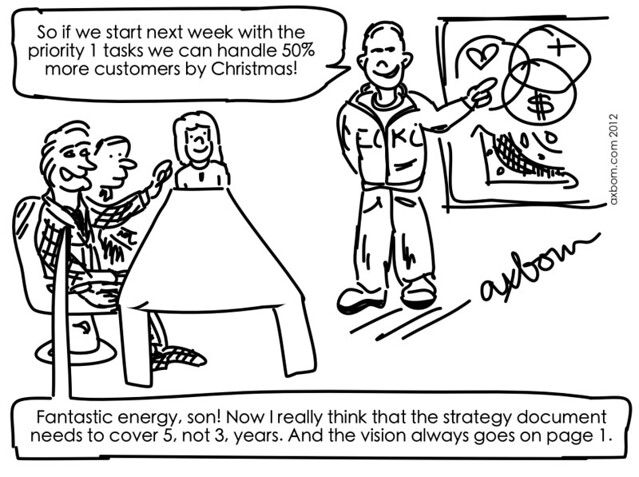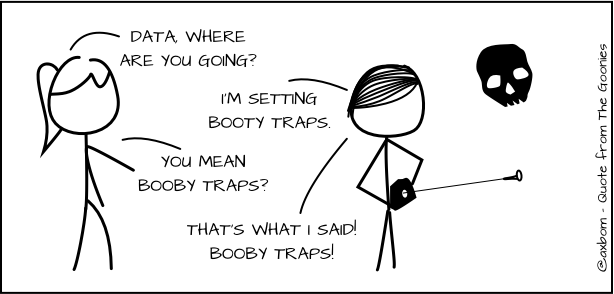
Now what’s that jedi mind trick for differentiating between vision, mission, objectives, tactics and goals again? And what parts go into a strategy document? The answer: it really doesn’t matter. Only one thing matters. I’ll tell you.
Running strategy workshops for companies by and large, it’s clear to me that there are many different perceptions of a strategy document. And oftentimes discussions deviate into academic trivia around the specific details of the document structure.
* For anyone unfamiliar with the term. A booby trap is a device built to capture or kill an animal or person, and triggered by the presence of the victim. I first heard the phrase in the 1985 film The Goonies, as it was in common usage by the inventive team member Data. “Booby” comes from the Spanish word bobo with the meanings “stupid, fool, idiot”.

The illusion of the best practice
It’s like managing a hockey team and arguing over the color of the planning board. Sure, it’s easier to argue about irrelevant details than play the game well. But it won’t help you score.
Early arguments about the definition of strategy and structure is an academic booby trap triggered by an inclination to assert ”real, proven knowledge” over ”sprawling enthusiasm”.
It’s a trap that slows you down and enforces the stale innovation-killing schooling that there is a single right way and wrong way to do things.
Stop it.
What you do is defined by purpose
Sometimes I think there’s a reason why many successful entrepreneurs didn’t go to college, or dropped out half-way. Sometimes I think it’s because they are more focused on getting the job done, than fitting the roadmap into a mold outlined by a 30 year old textbook.
Their small luck being they did not finish reading that book.
The problem at hand is not how to write a document in the same way everyone else does it. The problem you are trying to solve is how to create a gameplay for your organization that:
- everyone can understand and agree with,
- fits with the competencies and resources you have and
- allows realignment when outside factors change.
Here’s what you need to know
- Your strategy is a helpful guide, presented in a clear way that the entire organization can understand and sign off on.
- The guide helps people see how their work contributes to the larger picture, and in essence: what they should do more of and what they should do less of.
- The guide must be based on real knowledge; about people inside and outside, about the business, and about the tools you use.
What heading comes first in your document is not something you should spend hours on. But, really, your first mistake is deciding up front that the best you can do is produce a document.
Here’s a basic strategy for designing your strategy [sic]
- Talk to people from all parts of your organization, as well as outside stakeholders, about their challenges. ”Talking” is a loose term today; use that to your advantage. Start a Google Hangout, shoot the breeze on Twitter and use internal chat tools or, you know, e-mail. Reaching everyone is not as hard as you may want to argue.
- Put all your insights on a wall (yes, a physical wall) and brainstorm solutions.
- Prioritize the solutions according to a model that makes sense to you, e.g. SCARF (Severity, Clarity, Affordability, Return, Feasibility).
- Outline when you want to do what, and why (yeah, you should have just gotten the final data for your game plan in the previous step).
- Be transparent about your work and allow feedback from the organization. But also, touch base with your target group (the people who will use the strategy) in a proactive way, not passive.
- Communicate your strategy in the format best suited for understanding: a roadmap, infographic, diagram, slideshow or digital tool. Or much better: in several different formats because (1) you prove that you fully understand it yourself and (2) people will have more than one cue to help them move forward as a team. Again, use the benefits of new technological advances for communicating your message and enhance comprehension.
Don’t file your strategy, cultivate your game plan.
This does not have to take 2 months. Do it in 2 weeks and then do it again, faster and in new formats, each time evaluating how well the strategy does what it’s supposed to do: help people.
That’s right, the one thing that matters is: A working strategy helps people get on with doing the right things to contribute to successful results.
Now stop designing documents and start guiding your organization. It’s more fun to keep moving than being caught in a trap.







Member discussion